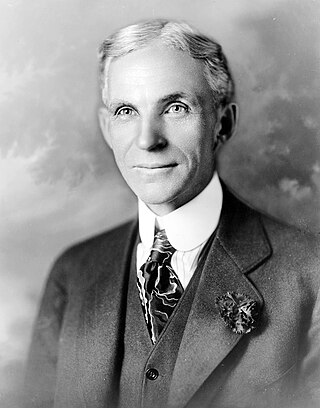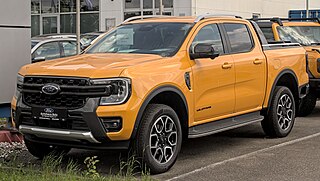Wayne Ford may refer to:
- Wayne Ford (politician) (born 1951), member of the Iowa House of Representatives
- Wayne Adam Ford (born 1961), American serial killer
- Wayne Ford (criminal) (born 1946), Canadian murderer
Wayne Ford may refer to:

Henry Ford was an American industrialist and business magnate. As the founder of the Ford Motor Company, he is credited as a pioneer in making automobiles affordable for middle-class Americans through the system that came to be known as Fordism. In 1911, he was awarded a patent for the transmission mechanism that would be used in the Ford Model T and other automobiles.

Marion Robert Morrison, professionally known as John Wayne and nicknamed "the Duke", was an American actor who became a popular icon through his starring roles in films which were produced during Hollywood's Golden Age, especially in Western and war movies. His career flourished from the silent era of the 1920s through the American New Wave, as he appeared in a total of 179 film and television productions. He was among the top box-office draws for three decades and appeared with many other important Hollywood stars of his era. In 1999, the American Film Institute selected Wayne as one of the greatest male stars of classic American cinema.

Harrison Ford is an American actor. Regarded as a cinematic cultural icon, he has been a leading man in films of several genres and starred in many major box-office successes, particularly in the 1980s and 1990s. His films have grossed more than $5.4 billion in North America and more than $9.3 billion worldwide. Ford is the recipient of various accolades, including the AFI Life Achievement Award, the Cecil B. DeMille Award, an Honorary César, and an Honorary Palme d'Or, in addition to an Academy Award nomination.

Stagecoach is a 1939 American Western film directed by John Ford and starring Claire Trevor and John Wayne. The screenplay by Dudley Nichols is an adaptation of "The Stage to Lordsburg", a 1937 short story by Ernest Haycox. The film follows a group primarily composed of strangers riding on a stagecoach through dangerous Apache territory.

The Quiet Man is a 1952 American romantic comedy drama film directed and produced by John Ford, and starring John Wayne, Maureen O'Hara, Victor McLaglen, Barry Fitzgerald, and Ward Bond. The screenplay by Frank S. Nugent was based on a 1933 Saturday Evening Post short story of the same name by Irish author Maurice Walsh, later published as part of a collection titled The Green Rushes. The film features Winton Hoch's lush photography of the Irish countryside and a long, climactic, semi-comic fist fight.

The Searchers is a 1956 American epic Western film directed by John Ford and written by Frank S. Nugent, based on the 1954 novel by Alan Le May. It is set during the Texas–Indian wars, and stars John Wayne as a middle-aged Civil War veteran who spends years looking for his abducted niece, accompanied by his adopted nephew. It was shot in VistaVision on Eastmancolor negative with processing and prints by Technicolor.

Dearborn is a city in Wayne County, Michigan, United States. It is an inner-ring suburb in Metro Detroit, bordering Detroit to the south and west, and roughly 7 miles (11.3 km) west of downtown Detroit. In the 2020 census, it had a population of 109,976, ranking as the seventh-most populous city in Michigan. Dearborn is best known as the hometown of the Ford Motor Company and of its founder, Henry Ford.

Maureen O'Hara was an Irish-born naturalized American actress who became successful in Hollywood from the 1940s through to the 1960s. She was a natural redhead who was known for playing passionate but sensible heroines, often in Westerns and adventure films. She worked with director John Ford and long-time friend John Wayne on numerous projects.

John Martin Feeney, known professionally as John Ford, was an American film director and producer. He is regarded as one of the most important and influential filmmakers during the Golden Age of Hollywood, and was one of the first American directors to be recognized as an auteur. In a career of more than 50 years, he directed over 130 films between 1917 and 1970, and received six Academy Awards including a record four wins for Best Director for The Informer (1935), The Grapes of Wrath (1940), How Green Was My Valley (1941), and The Quiet Man (1952).

The Man Who Shot Liberty Valance is a 1962 American Western film directed by John Ford and starring John Wayne and James Stewart. The screenplay by James Warner Bellah and Willis Goldbeck was adapted from a 1953 short story written by Dorothy M. Johnson. The supporting cast features Vera Miles, Lee Marvin, Edmond O'Brien, Andy Devine, John Carradine, Woody Strode, Strother Martin and Lee Van Cleef.

Grosse Pointe refers to an affluent coastal area next to Detroit, Michigan, United States, that comprises five adjacent individual cities. From southwest to northeast, they are:

Rio Grande is a 1950 American romantic Western film directed by John Ford and starring John Wayne and Maureen O'Hara. It is the third installment of Ford's "Cavalry Trilogy", following two RKO Pictures releases: Fort Apache (1948) and She Wore a Yellow Ribbon (1949). Wayne plays the lead in all three films, as Captain Kirby York in Fort Apache, then as Captain Nathan Brittles in She Wore a Yellow Ribbon, and finally as a promoted Lieutenant Colonel Kirby Yorke in Rio Grande. Rio Grande's supporting cast features Ben Johnson, Claude Jarman Jr., Harry Carey Jr., Chill Wills, J. Carrol Naish, Victor McLaglen, Grant Withers, the Western singing group the Sons of the Pioneers and Stan Jones.
Ford Fairlane may refer to:

Fair Lane was the estate of Ford Motor Company founder Henry Ford and his wife, Clara Ford, in Dearborn, Michigan, in the United States. It was named after an area in Cork in Ireland where Ford's adoptive grandfather, Patrick Ahern, was born. The 1,300-acre (530 ha) estate along the River Rouge included a large limestone house, an electrical power plant on the dammed river, a greenhouse, a boathouse, riding stables, a children's playhouse, a treehouse, and extensive landmark gardens designed by Chicago landscape architect Jens Jensen.

Patrick John Morrison, better known by his stage name Patrick Wayne, is an American actor. He is the second son of movie star John Wayne and his first wife, Josephine Alicia Saenz. He made over 40 films, including eleven with his father.

The Ford Building is a high-rise office building located at 615 Griswold Street in Downtown Detroit, Michigan. It stands at the northwest corner of Congress and Griswold Streets, in the heart of Detroit's Financial District. The Penobscot Building abuts the building to the north, and the Guardian Building is southeast across Griswold Street.
Rookie of the Year may refer to:
The Fort Wayne Open, which played for one year as Fort Wayne Invitational, was a golf tournament on the PGA Tour from 1950 to 1956. It was played in Fort Wayne, Indiana. In 1950 it was played at the Orchard Ridge Country Club before moving to the Fort Wayne Elks Lodge No. 155 golf course, now known as the "Elks Course" at Coyote Creek Golf Club, an 18-hole, par-72 championship course built in 1928 and opened in 1929.

The Ford Ranger is a compact or mid-size pickup marketed globally by Ford over a series of generations, varying between both in-house or outside development and manufacturing — and with a hiatus in North America from 2011–2018.

Clara Jane Bryant Ford was a suffragist and the wife of Henry Ford. She was inducted into the Michigan Women's Hall of Fame.